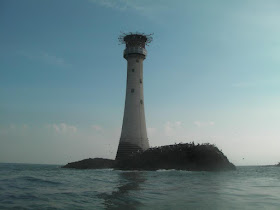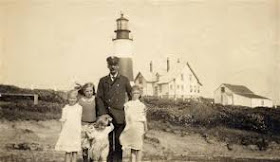 |
| Lighthousekeeper Geo Knott |
http://www.lighthousekeepers.co.uk/index.php/mnu-histories/10-art-firty-years
FORTY YEARS ON LIGHTHOUSES by A. Nethercott.
(A series of short articles about the life and times of a lighthouse keeper during the period 1920-60. The articles were written in the mid 1960s.)
Solitude
I wasn't at all impressed or pleased at the prospect of spending a month or two here, after I had thoroughly investigated the living and sleeping quarters and to think I should have this one man for a companion, day in, day out, with no means of even being alone. I began to loathe him. He had no conversation, topics of any type. I knew when he was going to sneeze, I think! And when sitting together at meals or endeavouring to read, he continually beat out "The Devil's Tattoo" with his fingers. I got him to discontinue this mad tapping after several weeks, but he began to tap, tap with his feet, no rhythm or sense, it just tended to drive one insane. I couldn't possibly get away for any length of time and as for exercise, I would shift out the two chairs and walk three paces one way and two the other, or walk up and down the ladder or on the narrow platform. The bars made my feet sore.
There was a boat in the davits I had hoped to use, but there were strict orders not to lower it, only in the event of a fire, the other reason was it was too heavy and I venture to say, unseaworthy. The whole place was a fire hazard, made of wood mostly with inflammables aboard such as paraffin, coal and explosives. I lived two months with that chap and look back on it as a nightmare. I began to hate everything about him. I knew what his next move would be, what he would touch or do or say (which was very little) then I would sit and wonder why I was there, what crime had I committed? This loneliness and frustration was getting me down. We hear so much about the poor convicts confined behind prison walls. At least he meets and talks with people, his loved ones are allowed to visit him, he receives letters, newspapers, someone to cook and provide him with fresh meals, vegetables, fruit etc. and almost all the amenities enjoyed by normal civilians. I spent hours and days trying to analyze my present environments - perhaps I thought too much and too deeply over these problems and found no solution. When I arrived there I received letters containing simple matters that could very easily have been dealt with on shore, but as the days and weeks passed by they seem to magnify and get exaggerated all out of proportion. The more I thought about them my mind was on the verge of collapse and looking back I can quite understand what solitude can do to a man. No news, no music, no wireless and no-one to talk over your problems or have discussions of any type.
FORTY YEARS ON LIGHTHOUSES by A. Nethercott.
(A series of short articles about the life and times of a lighthouse keeper during the period 1920-60. The articles were written in the mid 1960s.)
Solitude
I wasn't at all impressed or pleased at the prospect of spending a month or two here, after I had thoroughly investigated the living and sleeping quarters and to think I should have this one man for a companion, day in, day out, with no means of even being alone. I began to loathe him. He had no conversation, topics of any type. I knew when he was going to sneeze, I think! And when sitting together at meals or endeavouring to read, he continually beat out "The Devil's Tattoo" with his fingers. I got him to discontinue this mad tapping after several weeks, but he began to tap, tap with his feet, no rhythm or sense, it just tended to drive one insane. I couldn't possibly get away for any length of time and as for exercise, I would shift out the two chairs and walk three paces one way and two the other, or walk up and down the ladder or on the narrow platform. The bars made my feet sore.
There was a boat in the davits I had hoped to use, but there were strict orders not to lower it, only in the event of a fire, the other reason was it was too heavy and I venture to say, unseaworthy. The whole place was a fire hazard, made of wood mostly with inflammables aboard such as paraffin, coal and explosives. I lived two months with that chap and look back on it as a nightmare. I began to hate everything about him. I knew what his next move would be, what he would touch or do or say (which was very little) then I would sit and wonder why I was there, what crime had I committed? This loneliness and frustration was getting me down. We hear so much about the poor convicts confined behind prison walls. At least he meets and talks with people, his loved ones are allowed to visit him, he receives letters, newspapers, someone to cook and provide him with fresh meals, vegetables, fruit etc. and almost all the amenities enjoyed by normal civilians. I spent hours and days trying to analyze my present environments - perhaps I thought too much and too deeply over these problems and found no solution. When I arrived there I received letters containing simple matters that could very easily have been dealt with on shore, but as the days and weeks passed by they seem to magnify and get exaggerated all out of proportion. The more I thought about them my mind was on the verge of collapse and looking back I can quite understand what solitude can do to a man. No news, no music, no wireless and no-one to talk over your problems or have discussions of any type.
A New Mate
I was terribly depressed as time passed. Thank heavens I was able to draw and read and amuse myself with my mandolin. The two months had elapsed and I was instructed to stay another month. I read my letters from home, the newspapers and found that my future mate was a cheerful old chap. All the stress and worry simply disappeared as if it were a bad nightmare. To give my late companion his due, I must point out that to meet him on shore he was one of the nicest persons one could wish to know, excepting that he was of a reticent nature and found great difficulty in communicating his thoughts or views unfortunately. So I am not blaming him for my experiences of those two months. Men should never have been subjected to those conditions which were intolerable compared with present day standards.
I was terribly depressed as time passed. Thank heavens I was able to draw and read and amuse myself with my mandolin. The two months had elapsed and I was instructed to stay another month. I read my letters from home, the newspapers and found that my future mate was a cheerful old chap. All the stress and worry simply disappeared as if it were a bad nightmare. To give my late companion his due, I must point out that to meet him on shore he was one of the nicest persons one could wish to know, excepting that he was of a reticent nature and found great difficulty in communicating his thoughts or views unfortunately. So I am not blaming him for my experiences of those two months. Men should never have been subjected to those conditions which were intolerable compared with present day standards.





























